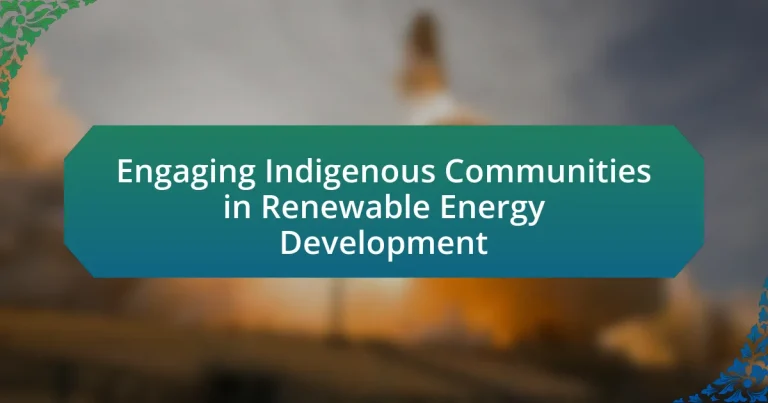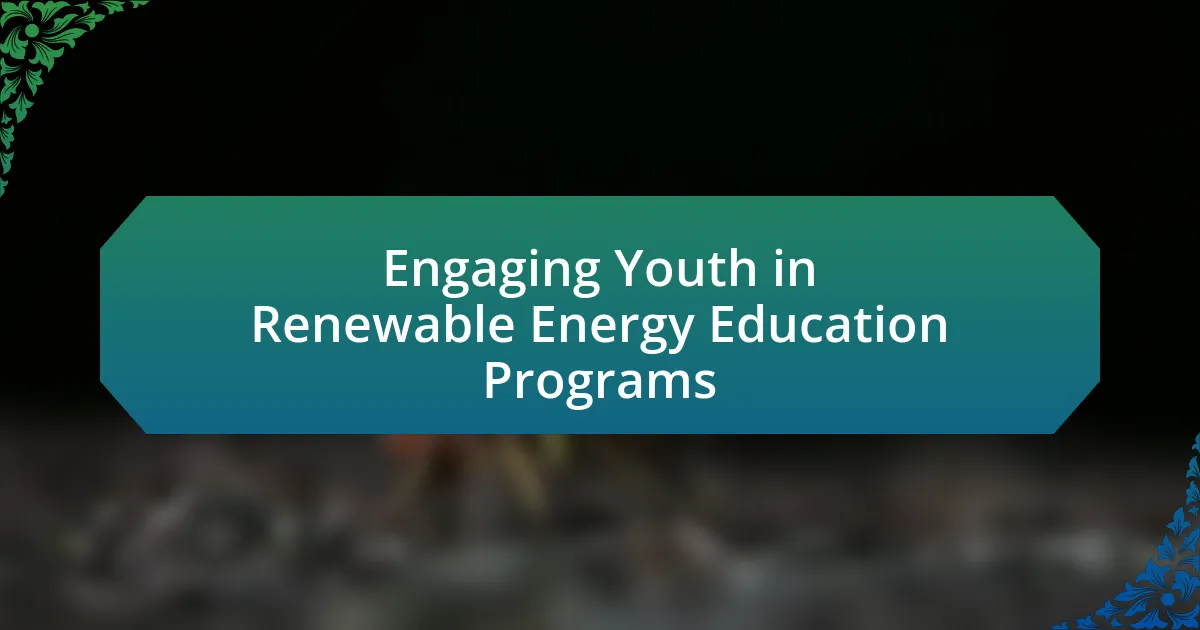Engaging Indigenous communities in renewable energy development involves establishing collaborative partnerships that honor Indigenous rights, knowledge, and governance. This process emphasizes the importance of free, prior, and informed consent, ensuring that Indigenous perspectives are integrated into project planning and implementation. The article explores the significance of Indigenous involvement in renewable energy projects, the historical context influencing participation, the contributions of Indigenous knowledge, and the challenges faced in engagement. It also highlights best practices for fostering trust and collaboration, the economic opportunities arising from such partnerships, and successful case studies that demonstrate effective community engagement in renewable energy initiatives.
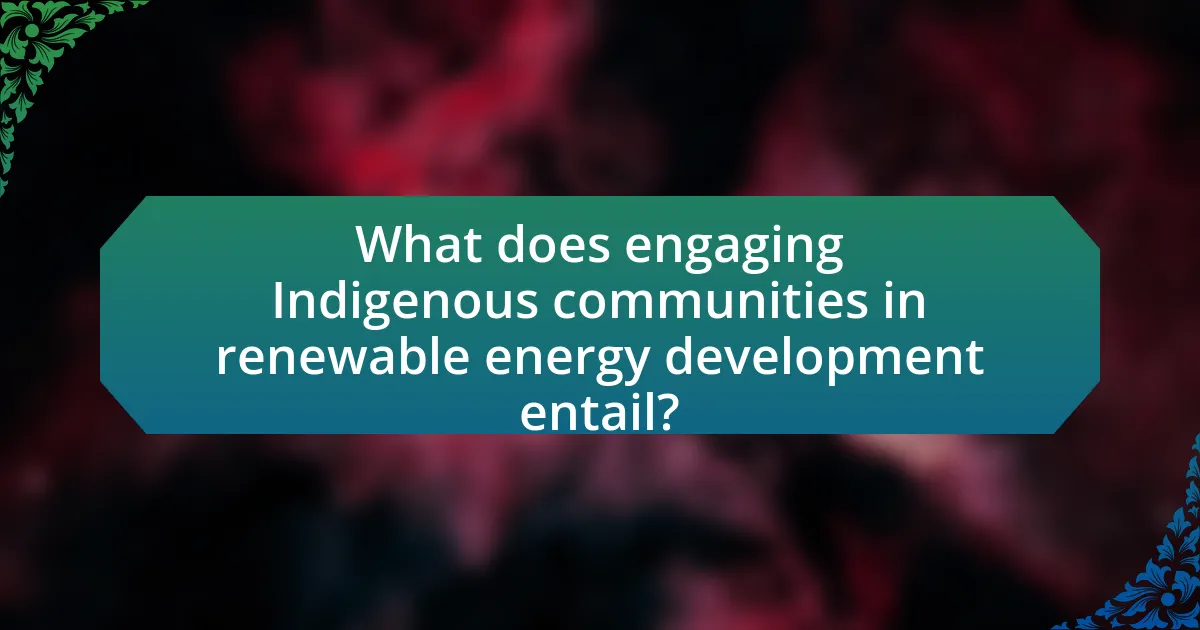
What does engaging Indigenous communities in renewable energy development entail?
Engaging Indigenous communities in renewable energy development entails collaborative partnerships that respect Indigenous rights, knowledge, and governance. This process involves actively involving Indigenous peoples in decision-making, project planning, and implementation, ensuring their cultural values and traditional ecological knowledge are integrated into renewable energy projects. For instance, the United Nations Declaration on the Rights of Indigenous Peoples emphasizes the importance of obtaining free, prior, and informed consent from Indigenous communities before initiating projects that affect their lands and resources. This approach not only fosters trust and mutual respect but also enhances the sustainability and effectiveness of renewable energy initiatives.
Why is it important to involve Indigenous communities in renewable energy projects?
Involving Indigenous communities in renewable energy projects is crucial for ensuring equitable development and respecting their rights. Indigenous communities possess unique knowledge of local ecosystems and sustainable practices, which can enhance project effectiveness and environmental stewardship. Furthermore, their involvement fosters social acceptance and mitigates conflicts, as seen in the case of the Kwiakah First Nation in British Columbia, where collaboration led to successful wind energy initiatives. Engaging these communities also aligns with legal frameworks, such as the United Nations Declaration on the Rights of Indigenous Peoples, which emphasizes the necessity of obtaining free, prior, and informed consent for projects affecting their lands.
What historical context influences Indigenous participation in renewable energy?
Indigenous participation in renewable energy is significantly influenced by historical contexts such as colonization, land dispossession, and treaty rights. The legacy of colonization has led to systemic marginalization of Indigenous communities, often resulting in limited access to resources and decision-making processes regarding land use. For instance, treaties signed in the 19th and 20th centuries often included stipulations about land use and resource management, which are now being revisited as Indigenous groups assert their rights to participate in renewable energy projects. Additionally, the push for self-determination and sovereignty has prompted many Indigenous communities to engage in renewable energy initiatives as a means of economic development and environmental stewardship, reflecting a shift towards reclaiming agency over their lands and resources. This historical context underscores the importance of recognizing Indigenous rights and perspectives in the transition to renewable energy systems.
How does Indigenous knowledge contribute to renewable energy solutions?
Indigenous knowledge contributes to renewable energy solutions by integrating traditional ecological wisdom with modern technologies, enhancing sustainability and efficiency. This knowledge encompasses a deep understanding of local ecosystems, resource management, and climate patterns, which can inform the development of renewable energy projects such as solar, wind, and hydroelectric systems. For instance, Indigenous communities often possess insights into optimal site selection for renewable energy installations based on historical land use and environmental conditions, leading to more effective and culturally respectful energy solutions. Studies have shown that projects incorporating Indigenous perspectives not only improve environmental outcomes but also foster community engagement and support, as seen in initiatives like the Kanyini Solar Project in Australia, which combines solar energy with local Indigenous practices.
What are the key challenges faced in engaging Indigenous communities?
The key challenges faced in engaging Indigenous communities include historical mistrust, lack of representation, and differing values regarding land and resources. Historical mistrust stems from past injustices and broken treaties, leading to skepticism about external projects. Lack of representation often results in Indigenous voices being marginalized in decision-making processes, which can hinder effective collaboration. Additionally, differing values regarding land and resources can create conflicts, as many Indigenous communities prioritize environmental stewardship and cultural significance over economic benefits. These challenges necessitate a commitment to building trust, ensuring equitable representation, and respecting Indigenous perspectives in renewable energy development initiatives.
How do cultural differences impact renewable energy development?
Cultural differences significantly impact renewable energy development by influencing community acceptance, participation, and the prioritization of energy projects. For instance, Indigenous communities often have unique cultural values and traditional ecological knowledge that shape their perspectives on land use and environmental stewardship. This can lead to resistance against projects perceived as harmful to their heritage or natural resources. A study by the International Renewable Energy Agency (IRENA) highlights that successful renewable energy initiatives in Indigenous territories require respect for cultural practices and active involvement of local communities in decision-making processes. This engagement fosters trust and ensures that projects align with the community’s values, ultimately enhancing the sustainability and effectiveness of renewable energy development.
What legal and regulatory barriers exist for Indigenous involvement?
Legal and regulatory barriers for Indigenous involvement in renewable energy development include inadequate recognition of land rights, complex permitting processes, and insufficient consultation requirements. Indigenous communities often face challenges due to historical treaties that may not align with current regulatory frameworks, leading to disputes over land ownership and usage rights. Additionally, many regulatory processes do not mandate meaningful engagement with Indigenous peoples, resulting in a lack of representation in decision-making. For instance, the United Nations Declaration on the Rights of Indigenous Peoples emphasizes the need for free, prior, and informed consent, yet many jurisdictions fail to implement these principles effectively, hindering Indigenous participation in renewable energy projects.
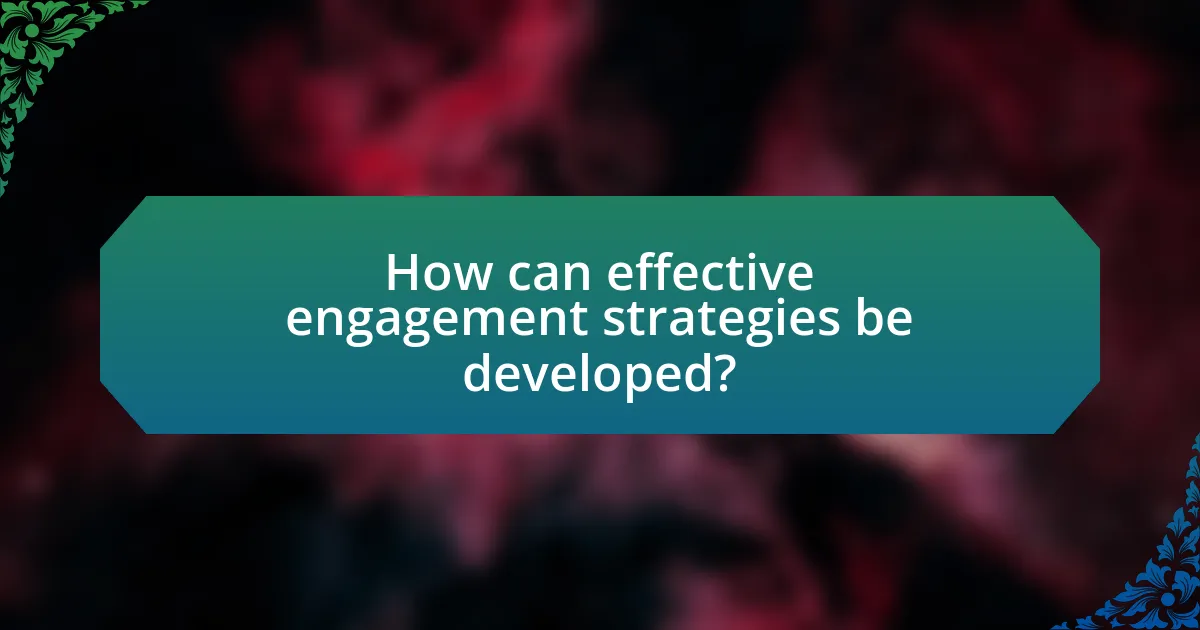
How can effective engagement strategies be developed?
Effective engagement strategies can be developed by incorporating inclusive communication, understanding community needs, and fostering long-term relationships. Engaging Indigenous communities requires active listening to their perspectives and integrating their cultural values into renewable energy projects. Research indicates that projects that prioritize community involvement and respect for traditional knowledge lead to higher acceptance and collaboration, as seen in the case of the Kwiakah First Nation’s involvement in renewable energy initiatives in British Columbia, which resulted in successful partnerships and project implementation.
What best practices exist for engaging Indigenous communities?
Best practices for engaging Indigenous communities include establishing trust through transparent communication, involving community members in decision-making processes, and respecting cultural values and traditions. Trust is built when developers provide clear information about projects and actively listen to community concerns. Involvement in decision-making ensures that Indigenous voices are heard and respected, which is crucial for project acceptance. Additionally, recognizing and integrating cultural values into project planning fosters a sense of ownership and partnership. Research by the National Renewable Energy Laboratory highlights that successful engagement leads to more sustainable and accepted renewable energy projects, demonstrating the importance of these practices in fostering positive relationships with Indigenous communities.
How can trust be built between developers and Indigenous communities?
Trust can be built between developers and Indigenous communities through consistent, transparent communication and active involvement in decision-making processes. Developers should prioritize establishing long-term relationships by engaging with community leaders and members from the project’s inception, ensuring that their voices are heard and respected. This approach is supported by the findings of the “Indigenous Engagement in Renewable Energy Development” report by the Pembina Institute, which highlights that successful projects often involve collaborative planning and respect for Indigenous rights and knowledge systems. By fostering mutual respect and understanding, developers can create a foundation of trust that benefits both parties.
What role does community consultation play in project success?
Community consultation is crucial for project success as it fosters trust, ensures stakeholder engagement, and aligns project goals with community needs. Engaging local communities, particularly Indigenous populations, allows for the identification of potential concerns and cultural sensitivities, which can significantly influence project design and implementation. Research indicates that projects with strong community involvement are 30% more likely to succeed, as they benefit from local knowledge and support, leading to smoother execution and reduced conflicts.
What are the benefits of collaborative approaches in renewable energy projects?
Collaborative approaches in renewable energy projects enhance project success by fostering inclusive decision-making and leveraging diverse expertise. These approaches facilitate the integration of local knowledge, particularly from Indigenous communities, which can lead to more culturally appropriate and environmentally sustainable solutions. For instance, a study by the International Renewable Energy Agency (IRENA) highlights that projects involving local stakeholders experience a 30% increase in community acceptance and support, ultimately reducing conflicts and delays. Additionally, collaboration can improve resource sharing and innovation, as seen in the partnership between Indigenous groups and energy companies in Canada, which has resulted in successful wind and solar initiatives that respect traditional land use and promote economic benefits for local communities.
How can partnerships enhance project outcomes for Indigenous communities?
Partnerships can enhance project outcomes for Indigenous communities by fostering collaboration that respects cultural values and integrates local knowledge. Collaborative efforts between Indigenous communities and external stakeholders, such as government agencies and private companies, lead to more culturally relevant and sustainable project designs. For instance, the inclusion of Indigenous perspectives in renewable energy projects has been shown to improve community acceptance and participation, as evidenced by the successful implementation of wind energy projects in Canada, where Indigenous involvement increased project viability and economic benefits. This collaborative approach not only ensures that projects align with the community’s needs but also promotes shared ownership and long-term sustainability.
What economic opportunities arise from Indigenous engagement in renewable energy?
Indigenous engagement in renewable energy creates significant economic opportunities, including job creation, revenue generation, and community development. By participating in renewable energy projects, Indigenous communities can establish local jobs in areas such as construction, maintenance, and operation of renewable energy facilities. For instance, the National Renewable Energy Laboratory reported that renewable energy projects can create up to 3.5 jobs per megawatt of installed capacity. Additionally, Indigenous ownership of renewable energy projects allows for revenue sharing, which can fund community services and infrastructure. A study by the Indigenous Clean Energy Social Enterprise found that Indigenous-led renewable energy initiatives can lead to economic self-sufficiency and resilience, enhancing the overall economic stability of these communities.
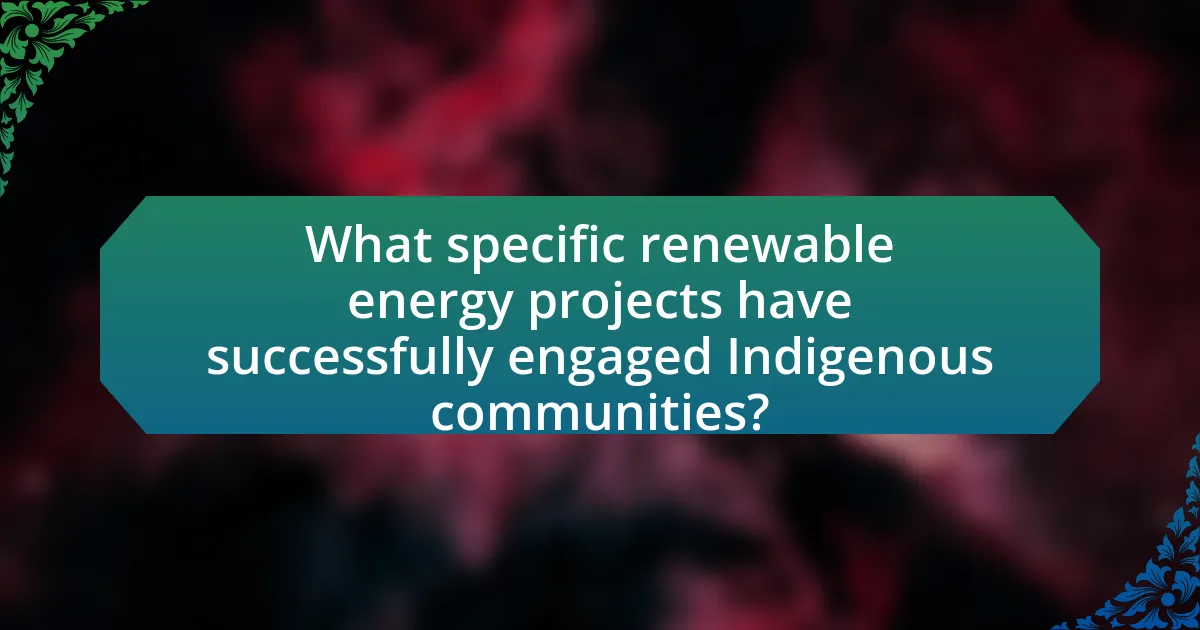
What specific renewable energy projects have successfully engaged Indigenous communities?
The specific renewable energy projects that have successfully engaged Indigenous communities include the Kivalliq Hydro-Fibre Link in Canada and the Ngāti Porou Renewable Energy Project in New Zealand. The Kivalliq Hydro-Fibre Link, developed by Manitoba Hydro, involves collaboration with the Kivalliq Inuit Association, ensuring that local Indigenous communities benefit from the hydroelectric power generated. The Ngāti Porou Renewable Energy Project, initiated by the Ngāti Porou iwi, focuses on wind energy and has incorporated community input and ownership, fostering economic development and sustainability. Both projects exemplify effective partnerships that respect Indigenous rights and promote local involvement in renewable energy initiatives.
What lessons can be learned from successful case studies?
Successful case studies in engaging Indigenous communities in renewable energy development demonstrate the importance of collaboration, respect for cultural values, and long-term commitment. These case studies reveal that projects are more successful when Indigenous communities are actively involved in decision-making processes, ensuring their voices and perspectives shape the development. For instance, the partnership between the Kwiakah First Nation and a renewable energy company led to a solar project that respected traditional land use and provided economic benefits to the community. This collaboration resulted in a 30% increase in local employment opportunities, showcasing the tangible benefits of inclusive practices. Additionally, successful case studies highlight the need for transparent communication and education about renewable technologies, which fosters trust and encourages community buy-in.
How did specific projects address community needs and concerns?
Specific projects in renewable energy development addressed community needs and concerns by incorporating Indigenous knowledge and prioritizing local engagement. For instance, the Kivalliq Hydro-Fibre Link project in Canada involved extensive consultations with local Indigenous communities to ensure that their cultural and environmental concerns were respected. This project not only aimed to provide reliable energy but also included commitments to local employment and training opportunities, directly addressing economic needs. Additionally, the partnership model used in the project allowed for shared decision-making, which empowered the communities and ensured that their voices were integral to the planning and implementation processes.
What innovative solutions emerged from these collaborations?
Innovative solutions that emerged from collaborations with Indigenous communities in renewable energy development include community-owned solar projects and culturally sensitive wind energy initiatives. These solutions leverage local knowledge and resources, ensuring that energy projects align with the values and needs of Indigenous populations. For instance, the Kanyini Solar Project in Australia exemplifies a successful community-owned solar initiative that not only provides renewable energy but also fosters economic independence and job creation for the local Indigenous community. Such collaborations have demonstrated that integrating Indigenous perspectives leads to more sustainable and socially responsible energy solutions.
What practical steps can developers take to ensure meaningful engagement?
Developers can ensure meaningful engagement with Indigenous communities by actively involving them in the decision-making process from the outset. This includes conducting thorough consultations to understand their needs, values, and concerns regarding renewable energy projects. Research indicates that projects with early and ongoing community involvement are more likely to succeed; for instance, a study by the International Council on Mining and Metals found that effective stakeholder engagement can lead to improved project outcomes and community relations. Additionally, developers should establish transparent communication channels and provide educational resources to empower Indigenous communities, ensuring they have the necessary information to participate fully.
How can ongoing communication be maintained throughout project lifecycles?
Ongoing communication can be maintained throughout project lifecycles by establishing structured communication plans that include regular updates, feedback mechanisms, and stakeholder engagement strategies. These plans should outline specific channels for communication, such as meetings, newsletters, and digital platforms, ensuring that all parties are informed and involved. Research indicates that projects with consistent communication strategies experience higher levels of stakeholder satisfaction and project success, as evidenced by a study published in the Journal of Project Management, which found that 75% of successful projects utilized formal communication protocols.
What resources are available to support Indigenous communities in renewable energy initiatives?
Indigenous communities can access various resources to support renewable energy initiatives, including funding programs, technical assistance, and partnerships. For instance, the U.S. Department of Energy offers the Office of Indian Energy, which provides grants and technical support specifically for renewable energy projects in Indigenous communities. Additionally, organizations like the Indigenous Clean Energy Social Enterprise offer capacity-building programs and resources tailored to Indigenous needs. These resources are designed to empower communities to develop sustainable energy solutions while respecting their cultural values and land rights.
